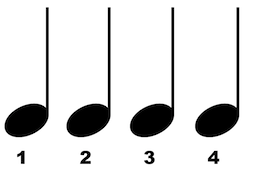Welcome back to another fun-filled guitar lesson on rhythm. Hopefully you’ve been working hard on whole notes and half notes, because this time we’re going to be exploring quarter notes.
If you’ve gone through the previous two lessons, then you can probably guess that a quarter note lasts for quarter the length of a whole note. Because whole notes last for four beats, then this means that a quarter note is a note that lasts for one beat.
Like whole notes and half notes, quarter notes have their own unique symbol that looks like this…

 If you look on the left hand side, you’ll see that the symbol for a quarter note is very similar to a half note symbol. (There’s an oval note head with a tail attached to it). But the major difference is that, for a quarter note, the note head is completely filled-in.
If you look on the left hand side, you’ll see that the symbol for a quarter note is very similar to a half note symbol. (There’s an oval note head with a tail attached to it). But the major difference is that, for a quarter note, the note head is completely filled-in.
Like the half note, you’ll quite often see the quarter note written in music with the tail attached to the opposite side of the note head. I’ve stuck an example of this on the right hand of this paragraph.
Quarter Note Timing Exercise
Let’s now look at a way of practising your quarter note timing with this exercise…

If you’ve practised the timing exercises in the lessons on whole notes and half notes, then you should already know the drill by now. But it’s probably a good idea to quickly review the steps you need to take…
- Decide on a single note on your guitar to play.
- Turn your metronome on, and make sure that it’s set to 60 bpm.
- Play the note you chose in Step 1 using all downstrokes. This will mean you have to play one note for each click of the metronome.
- Play the note repeatedly, using quarter note timing, for at least a couple of minutes.
As I’ve recommend before, I think it’s a great idea to tap your foot to the metronome click when you practice timing exercises. It’s also very helpful, at least initially, to count the beats out aloud.
Quarter Note Chord Progression
What we’re going to do now is look at an example chord progression that is largely comprised of quarter notes…

This is the exact sequence of chords that the chord progressions from the previous lessons used. But because most of the chords are now being played as quarter notes, it has changed the progression in the following two ways…
- The chord progression now only lasts for 12 beats total.
- To my ears, the chord progression has a more aggressive feel than when the chords are played with either half notes or whole notes.
A Few Last Words
That’s about it for now. We’re going to be talking about eighth notes in the next lesson, so please make sure that you practice the timing exercise and chord progression lots. It would also be a fantastic idea to review the lessons on whole notes and half notes. (You can’t go over the fundamentals of rhythm too much!).
Until next time, have fun!
Return To: Guitar Music Theory Lessons